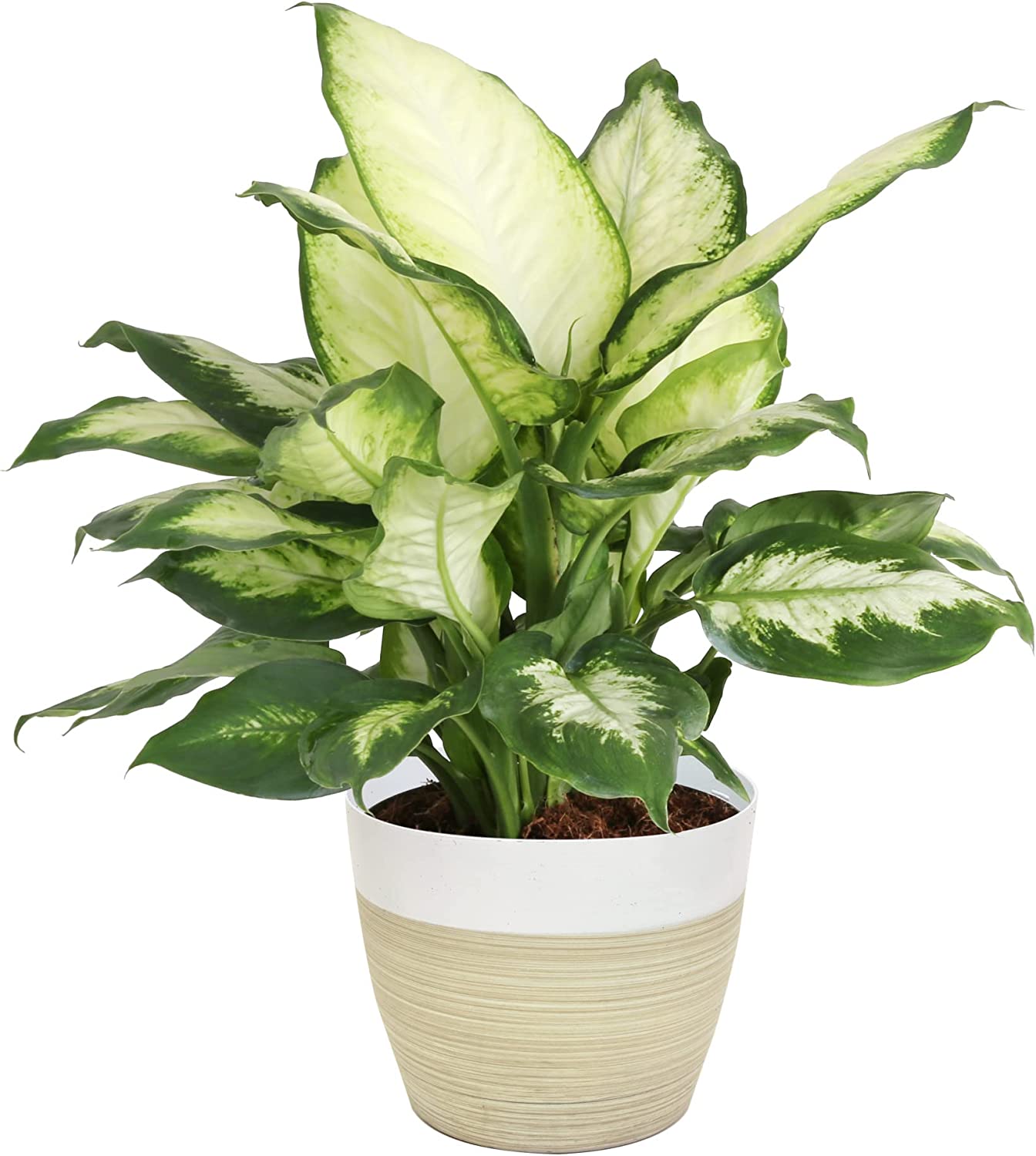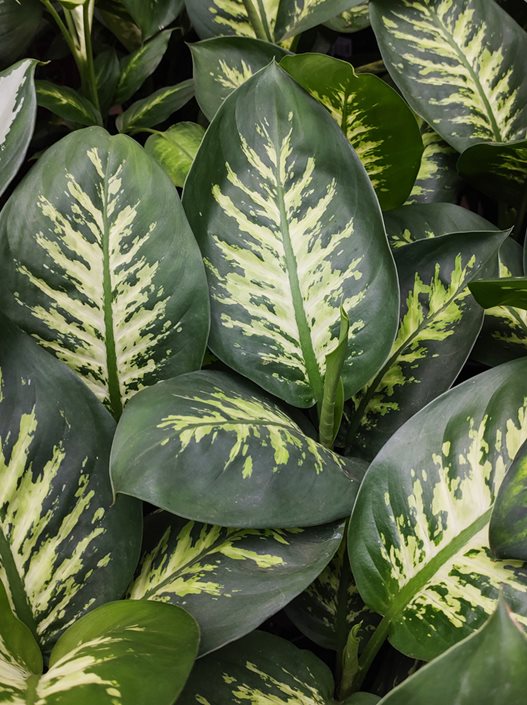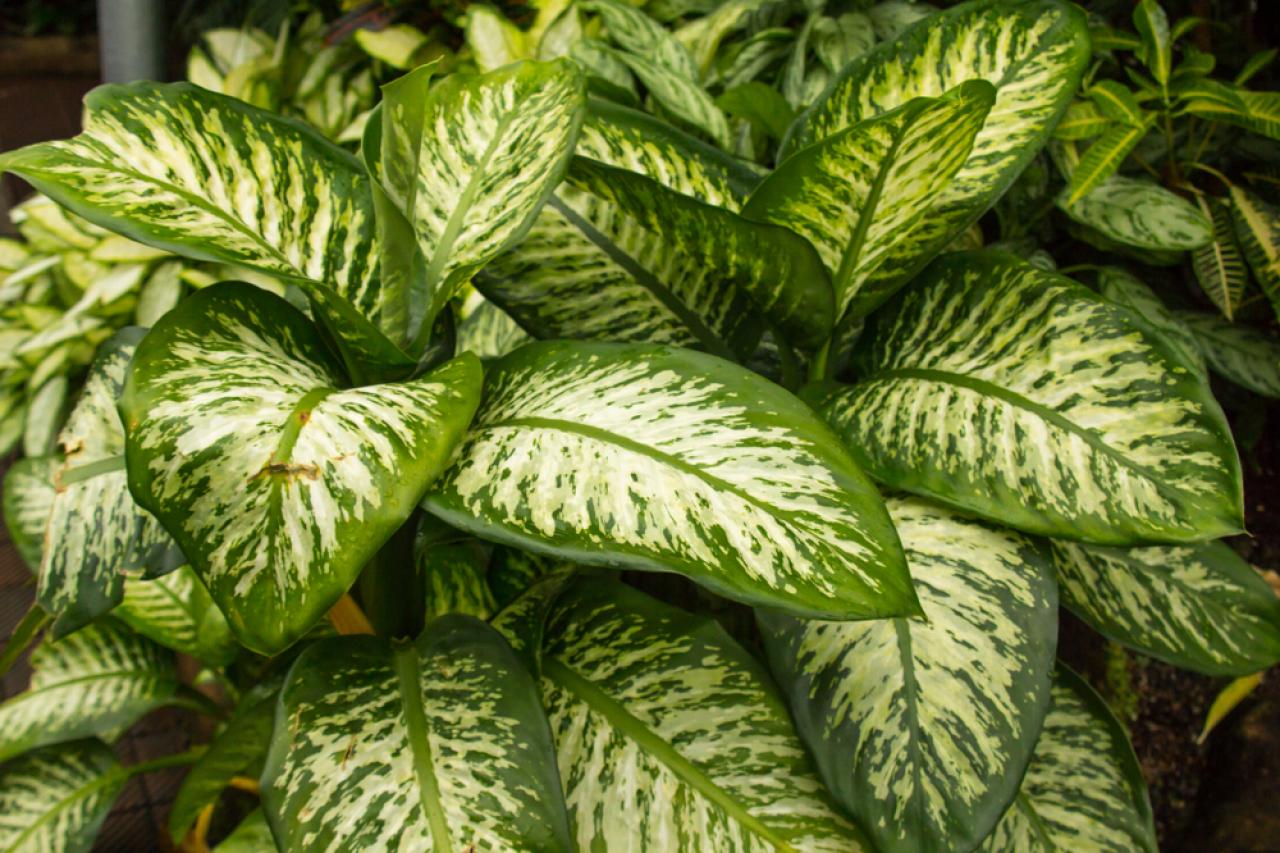
A Dieffenbachia is a popular houseplant for several reasons. The patterns on the leaves are beautiful, it is a fairly strong houseplant, it grows fast and can last for years. On this page you can read everything about the care of the Dieffenbachia, fun facts and answers to frequently asked questions.
Table of Contents
Dieffenbachia care
Habitat and light
When determining the location and the amount of light, it is good to remember that the Dieffenbachia originally comes from the tropical rainforest. In this natural habitat, the light is long, but the Dieffenbachia never sees the sun directly. This is because there are always tall trees that block the direct rays of the sun during the afternoon hours. Only during the morning and evening is the sun low enough to shine under the trees, onto the leaves of the Dieffenbachia.
In this way, you must also provide light for the Dieffenbachia as an indoor plant. So put her in a position where she gets plenty of light, but only direct sunlight in the morning and/or evening. This also applies to its relatives with variegated leaves such as the Syngonium. Your Dieffenbachia will let you know when something is not right in terms of sun or shade:
- Brown leaves on the Dieffenbachia? Or brown edges to the leaves? Then she gets too much direct sunlight. Place it a little further away from a window. By the way, you don’t have to see completely brown leaves if the Dieffenbachia is receiving too much light. Brown spots on the leaves are also a signal for this.
- If the print fades, that is a sign for too much shade. In too little light, the beautiful Dieffenbachia will lose its colors and patterns, or at least let them fade. In that case, move her a little closer to a window.
A Dieffenbachia grows toward the light. Like an Alocasia, the plant can grow crooked. You can prevent this by turning the plant a quarter turn every few weeks.
Habitat and temperature
In addition, the location often affects the temperature at which your Dieffenbachia must grow. Factors that influence the temperature:
- The location of the plant (south, north, east or west facing window)
- The distance of the plant from the window (the closer the window, the warmer)
- Double or single glass (single glass is often cold in winter)
- Air conditioning (does not like a Dieffenbachia)
- Radiators (a Dieffenbachia does not like these either)
- Draught
When it comes to temperature, your Dieffenbachia will also give you weather signals. In general, the plant prefers to be a little too warm than too cold. Too cold: the leaves fall off. If the Dieffenbachia loses leaves without them first turning yellow, this is a sign that the temperature is (has been) too low. It is therefore a shock reaction.It is best to keep the temperature fairly constant and always above 14 ℃.
Watering Dieffenbachia
When watering the Dieffenbachia, the trick is to always keep the potting soil slightly moist, without the soil being really wet. The easiest method is to stick a finger into the potting soil. Does soil stick to your finger? Then the soil is still wet and there is no need to water yet. Is there no soil sticking to your finger? Then the soil is dry and you can water.
When and how much water you give depends on several factors. A large plant consumes more than a small one. And in the winter your Dieffenbachia needs less water than in the summer. So it is really important to feel and judge whether you need to water. Over time, you will become more adept at this and can develop a set routine.
In addition, the Dieffenbachia will tell you when it has not been watered for too long. When the leaves curl it is time to water. Curling leaves when thirsty is also seen in other tropical plants such as the Calathea.On the other hand, limp leaves. If you notice limp leaves and soft stems, then the Dieffenbachia has had too much water for an extended period of time. More on that below.
Prevent root rot
Slack leaves and a soft stem are therefore always a sign that the Dieffenbachia has had too much water. More specifically: The roots of the plant have been standing in soggy soil for too long. Over time, this causes root rot. Root rot is unfortunately a problem that occurs regularly in houseplants, including the Dieffenbachia.
This sounds strange, after all a Dieffenbachia can live in hydroponics? The problem lies in the composition of the soil. If it stays wet for too long it will rot, and so will the roots. Rotten roots can no longer do their job: transporting nutrients through the plant. You notice root rot therefore by limp or yellow leaves that later fall off. Eventually the Dieffenbachia will die of root rot.
You can prevent root rot by not giving too much water, but in practice this is often not enough. Therefore, always make sure that there are holes in the bottom of the pot. This way, excess water can run out of the pot and will not remain around the roots.
Humidity
As written above, the Dieffenbachia originally comes from the tropics. There, the air humidity is very high. In order to imitate this natural habitat as closely as possible, it is wise to do something about the (often much too low) air humidity. This can be done in a number of ways:
- Spray: mist the leaves of the Dieffenbachia with a plant sprayer on mist setting.
- Use a humidifier.
- Put several tropical plants (for example, the Strelitzia and the Grass Lily) together, this creates a microclimate from which they all benefit.
- Place the Dieffenbachia in the bathroom. Here the humidity is often very high. Make sure that the plant gets enough daylight here as well.
A high humidity has several advantages:
- The leaves stay beautiful: you are less likely to have brown leaf edges.
- Dust does not stay on the leaves as easily: better photosynthesis = better growth.
- Lice, such as aphids, do not like to settle on leaves that are regularly wet.
- If the new leaves do not open, high humidity helps to ease this process.
Pruning
Is your Dieffenbachia getting too big? Then you can choose to prune her. Other reasons to prune can be: a bare trunk, leaves die or leaves are no longer beautiful.Always prune with gloves on: the juice of the Dieffenbachia is poisonous and can irritate the skin. Prune leaves as desired to get the plant back into shape. The Dieffenbachia will sprout again where you have pruned it back.Do not throw away the cut pieces, you can let them grow into new plants. Read more about Dieffenbachia cuttings.
Dieffenbachia repotting
A Dieffenbachia can grow quite large. Depending on the species, a height of three meters is certainly not unthinkable. To reach this height, the Dieffenbachia needs to have enough space in the pot. Since this plant can grow quite fast, repotting every two years is necessary. This way the plant has enough room for new roots and new leaves.
It is best to repot in the spring. Repotting a Dieffenbachia is an intervention that can easily (unintentionally, of course) damage the roots and/or leaves. By repotting in the spring, the plant still has the full growth phase to recover.
Always use fresh potting soil when repotting. Universal potting soil for houseplants is suitable. Keep in mind that new potting soil (usually) contains nutrition for a longer period. Do not add extra plant nutrition during this period.
Dieffenbachia nutrition
A Dieffenbachia grows quickly. With the right care, this plant can grow by 30 to 40 centimeters per year! Support this growth with plant food during the growth phase (spring to summer/early autumn). It is best to use organic plant food.
Always follow the instructions on the packaging carefully. A surplus is often given quickly and can cause serious damage to the roots. A surplus of nutrition in the pot manifests itself in brown and dead leaves. Often the plant will eventually die from this. Prevent this and dilute the plant food according to the label.
Dieffenbachia species
There are about 30 species of Dieffenbachia. The species is named after Joseph Dieffenbach (1796-1863).Almost all Dieffenbachia species have variations on the leaves. Only a few species have completely green leaves. Dieffenbachia species also differ in the maximum height they can reach. There are species that can reach up to three meters in height. At that height, they have impressive leaves.The most common species as houseplants are:
- Dieffenbachia seguine
- Dieffenbachia reflector
- Dieffenbachia camilla
- Dieffenbachia amoena
- Dieffenbachia green magic
- Dieffenbachia compacta
- Dieffenbachia tropic snow
- Dieffenbachia mars
- Dieffenbachia maroba
- Dieffenbachia reeva
- Dieffenbachia vesuvius
- Dieffenbachia crocodile
- Dieffenbachia maculata
- Dieffenbachia big ben
- Dieffenbachia oerstedii
- Dieffenbachia white etna
- Dieffenbachia tiki
Dieffenbachia flower
A Dieffenbachia flower appears when the plant is very happy. The care and conditions must be perfect. Should you remove the flower? Keeping a Dieffenbachia in bloom takes a lot of energy from the plant. You can choose to remove the flower so that the energy can go back to growing leaves. After about a week, the flower will have finished blooming and then you can remove it anyway
The flower may look familiar: The Dieffenbachia is part of the Arum family. Within this family are many well-known houseplants that produce similar flowers: among others, the Monstera (Hole plant) and the Alocasia (Elephant ear).
Buy Dieffenbachia
They can be bought small, but very large Dieffenbachia are also available. Where is the best place to buy Dieffenbachia? It is best to use a comparison site, where you can easily compare prices of different suppliers and always have the best buy. The button below will take you to the Dieffenbachia range at bol.com:
Frequently asked questions and problems
Dieffenbachia has brown leaves
Brown leaves on the Dieffenbachia are often a signal of two possible causes:
- The Dieffenbachia has been watered for too long, too much. This is when the brown leaves usually begin to have brown edges. Make sure the soil dries up almost completely between waterings. Also, excess water should be able to drain from the pot through holes in the bottom.
- The Dieffenbachia gets too much light. That’s when brown leaves with brown spots begin to appear. Move the plant to a place where it gets less (direct) sunlight.
Dieffenbachia hangs limp
Do you see the leaves drooping? Then, in general, there are two things that could be going on. The most common reason for droopy leaves is a thirsty Dieffenbachia. Is the soil dry? Then water it and see that the limp leaves straighten up again. If the Dieffenbachia hangs limply and also drops its leaves, it is often too cold for the plant.

The Dieffenbachia is very good at purifying the air. The larger the leaf area, the more air a plant can purify. Like many Philodendron species, this plant has a lot of leaf area. So it’s perfect for cleaner air in your home!
How tall does a Dieffenbachia grow?
The height of a Dieffenbachia varies per species. Most species remain around one meter, but a few can reach two or three meters in height.Looking for something bigger? Many Calathea species grow quite a bit taller, but also have the beautiful leaf pattern like a Dieffenbachia. Another option is to go for a houseplant on a stem like a Yucca or the easy Dracaena.
The leaves drip
The Dieffenbachia is leaking water! It’s natural to wonder what’s going on here, but luckily this is quite normal. The drops on the leaves are, as it were, “sweat” from the plant. Due to a temporary surplus of water in the plant, it comes out through the leaves. This is called guttation and is also seen in other houseplants such as the banana plant. Nothing wrong with that!
My Dieffenbachia is not growing
If your Dieffenbachia is not growing, there are several things going on:
- It is autumn/winter. During this time, most houseplants do not grow.
- The Dieffenbachia is in too much shade. Every plant needs light to grow properly.
- The pot is too small and the plant has too little root space.
- There is not enough nutrition in the pot.
- The plant is not getting enough water.
What are those black bugs?
Black little flies around the Dieffenbachia? Those are mourning flies. Read more about how to control mourning flies.

| Botanical name | Dieffenbachia |
| Family | Araceae (Arum family) |
| Maximum height | 3 meters (the largest species) |
| Demand for water | Average |
| Demand for light | Lots of light, sun in the morning and evening |
| Air-purifying? | Yes |
